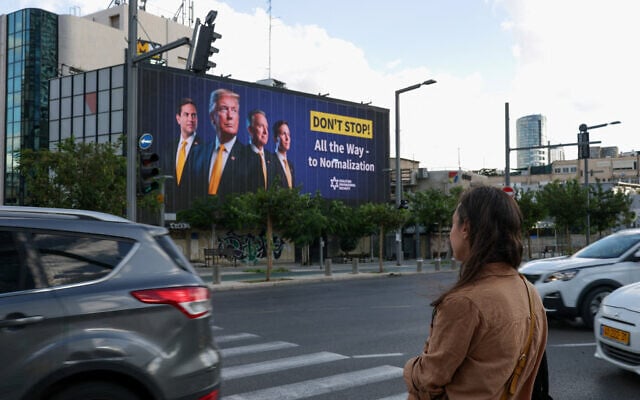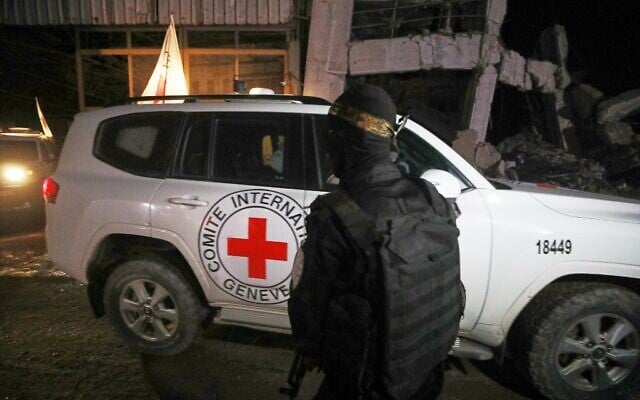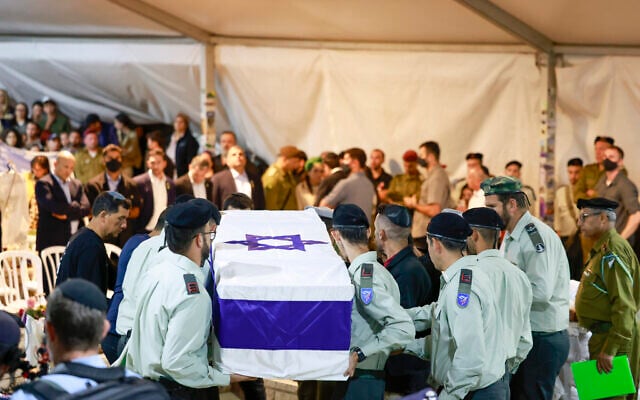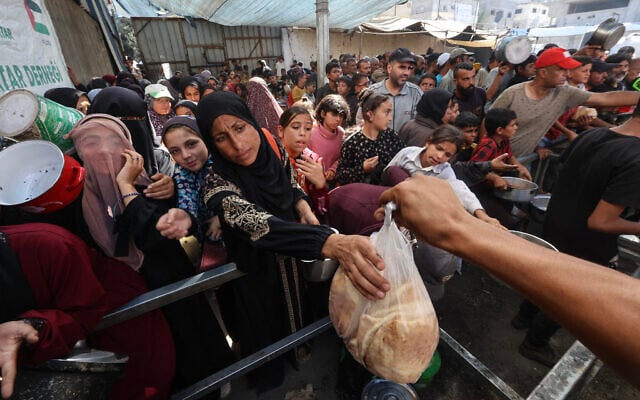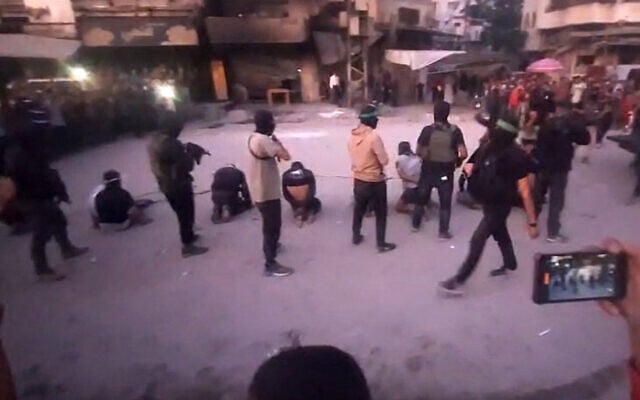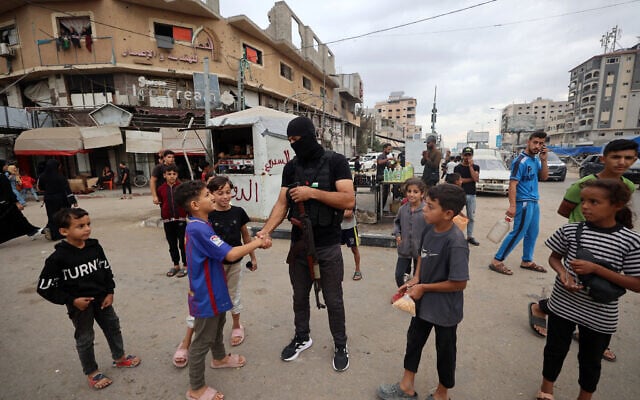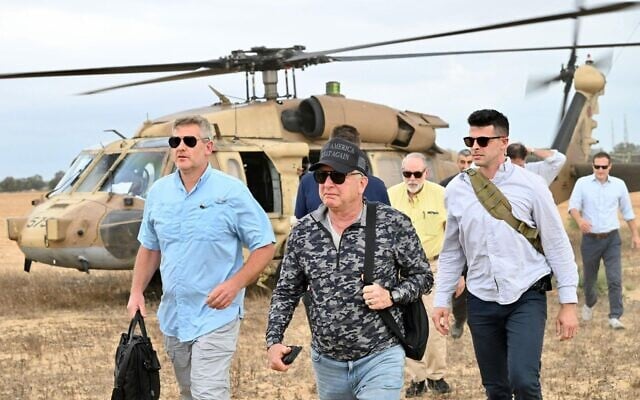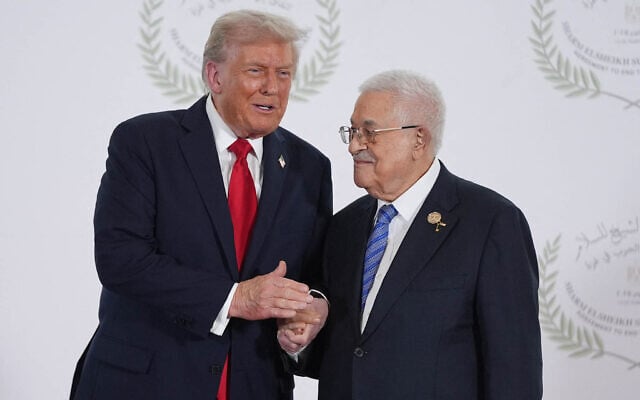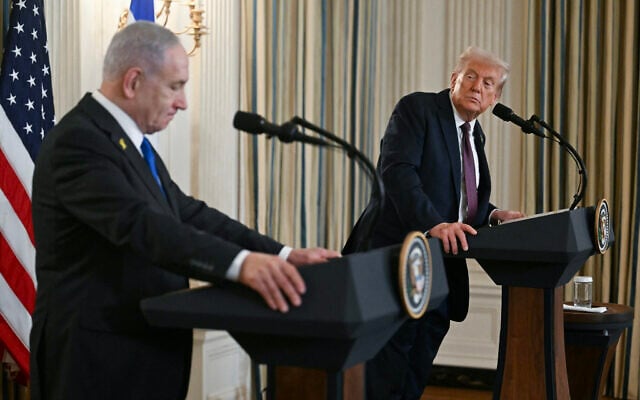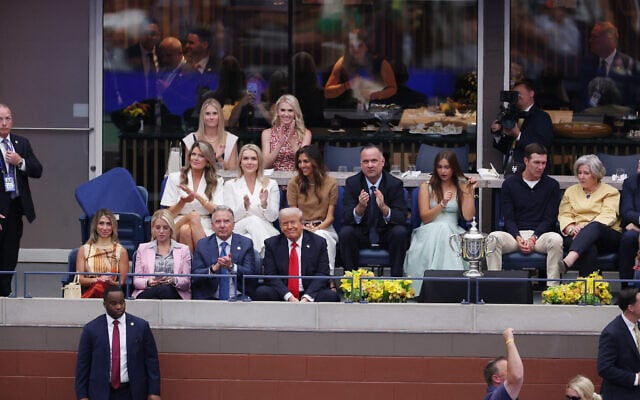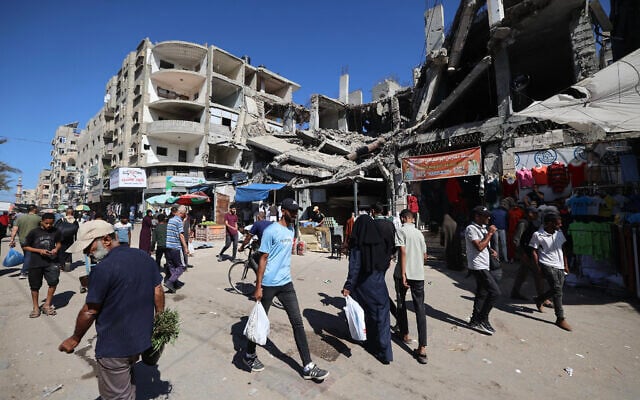

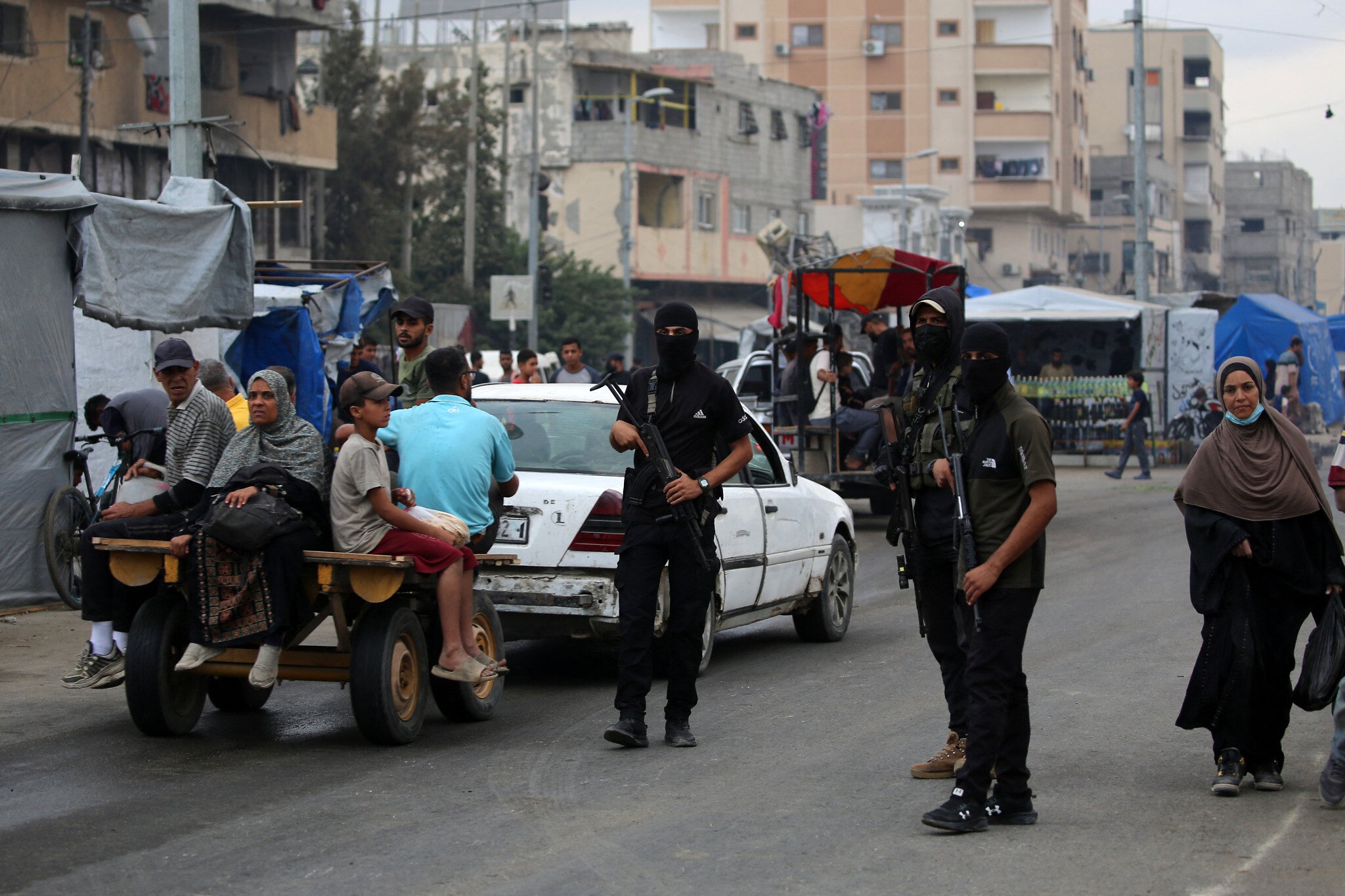
The United States denied on Wednesday that Hamas is violating the ceasefire deal with Israel, insisting that a dragged-out process to return the bodies of hostages held in Gaza was expected, given the difficult conditions on the ground.
“We’ve heard a lot of people saying, ‘Hamas violated the deal, because not all the bodies have been returned.’ The understanding we had with them was we get all the live hostages out, which they honor[ed],” said a senior adviser to US President Donald Trump during a briefing with reporters.
The top Trump aide was joined by a second senior Trump adviser for a briefing that covered a range of topics concerning the implementation of the remaining parts of Trump’s plan to end the Gaza war.
In addition to effectively defending Hamas’s efforts to retrieve the remaining bodies still held in Gaza, the Trump advisers revealed that the US is working with Israel to set up a safe zone inside the areas of Gaza still controlled by the IDF to which Palestinian civilians fearing Hamas retribution can flee.
They acknowledged that the demilitarization of the Strip will be complex, but expressed hope that limiting the redevelopment of Gaza to areas that are Hamas-free will help advance the effort.
The Trump advisers said many countries have offered to contribute to the International Stabilization Force that is slated to secure Gaza in place of Israel during the transitional postwar period, per Trump’s 20-point plan for ending the conflict.
The Trump advisers stressed that Gazans will not be forced to leave the Strip while it is being rebuilt, in a notable about-face from the administration’s initial stance upon Trump’s return to office, when they insisted that Gaza was uninhabitable and that Palestinians should therefore leave while the US takes it over and turns the enclave into the “Riviera of the Middle East.”
The pair concluded the briefing by detailing efforts to recruit Palestinians to take part in the transitional technocratic government that will administer postwar Gaza, knocking the existing Palestinian Authority as they made the case for relying on Palestinian living abroad.
The beginning of the briefing focused on the latest news relating to the retrieval of hostages’ bodies, with Israel arguing that Hamas is in violation of the ceasefire inked last week as the document gave the terror group 72 hours to return all 20 living hostages and all 28 deceased hostages’ remains.
While the deal’s deadline applies to the bodies as well, the text appears to recognize that Hamas may need more time to locate all of them, stipulating that the mediators will set up a joint task force to assist in finding all the remains not returned within 72 hours, and requiring Hamas to “exert maximum effort to ensure the fulfillment of these conditions as soon as possible.”
“Right now, we have a mechanism in place where we’re working closely with mediators… to do our best to get as many bodies out as possible,” the first senior Trump aide said during the briefing, conducted on condition of anonymity. “We continue to give [the mediators] the intelligence that the Israelis have [on where bodies may be located] and we keep working in good faith until we are able to exhaust that mechanism.”
The second top Trump adviser on the briefing — also speaking on condition of anonymity — said, “Hamas did the right thing when they gave all of the 20 live hostages up at the same time. That was a big moment.”
The second Trump adviser stated it was only possible for Hamas to begin retrieving bodies once the ceasefire came into place last week, as Gaza had been an active war zone.
The amount of debris in Gaza dwarfs what was left after the World Trade Center was bombed on 9/11, the second Trump aide claimed. “On top of all that debris is a lot of unexploded ordinance, and presumably, under that… there are many bodies.”
“It would have been almost impossible for Hamas — even if they knew where all the 28 bodies were — to mobilize and get them all,” said the second Trump adviser.
“First, we got three. Then we got four. Then we got another four,” the aide continues, citing incorrect figures on the number of bodies Hamas returned. It transferred four bodies on both Monday and Tuesday, though one of those was later identified as a Palestinian, while only two bodies — not four — were returned on Wednesday.
“We’re probably going to put together some program where we’re going to ask [Gazans] to see if they can help us to locate bodies, and we’re going to pay rewards for that type of good behavior,” the second Trump adviser revealed.
He added that the US has been in touch with Turkey, which is willing to send experts to help retrieve bodies, as they have experience derived from earthquake relief. It’s unclear whether Israel will accept such assistance, given the bad blood between Prime Minister Benjamin Netanyahu and Turkish President Recep Tayyip Erdogan.
“The sentiment in Israel is always [that Hamas] can do more. What we basically say to the Israeli side… is, ‘Give us whatever intelligence you’re hearing or seeing… If you think that there’s something [the mediators or Hamas] could be doing or should be doing that you don’t think they’re doing, then pass it over and we’ll convey it,” the first Trump adviser said.
While recognizing the complexity of the effort, the second Trump adviser stressed that the US is committed to retrieving all remaining bodies of hostages, which American Ambassador to Israel Mike Huckabee on Wednesday noted include US citizens Itay Chen and Omer Neutra.
“We’re not going to leave here until everybody comes home… Nobody is getting left behind,” he said.
Trump indicated earlier Wednesday that he would even allow Israel to resume fighting in Gaza if Hamas does not uphold the terms of the hostage deal inked last week.
“Israel will return to those [Gaza] streets as soon as I say the word,” Trump told CNN in a phone interview. “If Israel could go in and knock the crap out of them, they’d do that.”
While he recognized that Hamas has yet to return the vast majority of the deceased hostages held in Gaza before the deal took effect, he said, “Getting those 20 [living] hostages out was paramount.”
As for his efforts to coax Netanyahu into agreeing to the Gaza ceasefire deal, Trump said, “I had to hold them back… I had it out with Bibi.”
The Trump aides also said the US is working with Israel to set up a safe zone inside IDF-controlled parts of Gaza for Palestinians fleeing Hamas.
The initiative is part of the US response to the summary executions that Hamas has carried out since the ceasefire came into place last week against dozens of Palestinians from rival gangs and those it has accused of collaborating against Israel. Trump initially justified the executions, arguing that the victims were members of “very bad gangs,” but he has since softened his stance slightly and said he’s looking into the matter further. The commander of US forces in the Middle East has taken a harder line, issuing a statement demanding that Hamas cease its targeting of “innocent Palestinian civilians.”
Commenting on the issue during the briefing, the first senior Trump adviser said, “The US working with Israel to try and create some space in the safe zone behind the Yellow Line for people who feel [under] threat to be able to go to so.”
The Yellow Line is the boundary inside Gaza to which the IDF pulled back upon the implementation of the ceasefire, reducing its control over Gaza slightly to 53% of the territory.
“This is in response to the reports we’ve been seeing of Hamas executing rivals,” the first senior Trump adviser said, hailing Israel’s willingness to cooperate with the effort.
Israel is “making a big effort to try to embrace and protect and help those who want to live peacefully side by side and who are renouncing Hamas and wanting to choose a different path,” he added.
No timeline was given for when it will be implemented, and Israel has yet to publicly confirm that it is on board.
As for the demilitarization of Gaza, the first Trump adviser argued, “It’s not realistic to think everyone’s just going to walk in, drop their arms and say, ‘There you go.'”
“A lot of the people — even on the Hamas side — are fearful of retribution from other people inside Gaza. So it’s a very complex dynamic,” he continued.
“But the sentiment from the Arab mediators and from us is that they still want to continue to work together to find a way to do it,” the first Trump adviser added. “We’re all working very closely, creatively and aggressively to find the right outcome that satisfies everyone’s objectives.”
Regardless, he asserted that all mediators agree that “no rebuilding money will go into areas that Hamas controls.”
“Hamas-free, terror-free zones” will be rebuilt first, and those areas “hopefully can be the examples for what could be possible in the whole place if this program is successful.”
“We’ll know over the coming weeks if the right plan develops” for demilitarizing Gaza, the first Trump adviser said.
“If Hamas tries to reconstitute in a way that will pose a long term threat for Israel, that would be a violation of the agreement, but we’re not at a point yet where anyone feels like the agreement has been violated,” he added.
Trump’s 20-point plan for ending the war explicitly states that Palestinians will be encouraged to stay in the Gaza Strip, but reporters have continued asking whether anyone will be forced to leave.
The American president proposed in February that the US take over Gaza and permanently relocate the Strip’s entire population. While the idea was widely embraced in Israel, it was overwhelmingly rejected by the rest of the international community and Trump eventually distanced himself from the initiative.
The US president’s proposal was unveiled shortly after his special envoy Steve Witkoff visited Gaza and declared that the enclave was largely uninhabitable as it was full of unexploded ordnance.
But in the Wednesday briefing, the second senior Trump adviser indicated that Washington has undergone a complete about-face on the matter.
“These are tough people. They’ve been through a lot, and they seem to be resilient. They’re coming back to their homes, and they’re pitching tents. People feel very invested in the places where they live. It’s remarkable to see,” he said.
“While there are Gazans who have left because the living conditions are that difficult… no one is forcing any Gazans to leave,” the senior Trump adviser added.
Replacing Hamas as the administrator of Gaza will be a transitional committee of Palestinian technocrats, the Trump plan envisions.
The first Trump adviser said the US is currently working to fill this technocratic committee. However, he indicates that Washington is prioritizing deconfliction, ramping up humanitarian aid, recovering hostages’ remains and demilitarizing Gaza.
Nonetheless, individuals have reached out in the meantime to express interest in joining the technocratic government because they realize that “Hamas is weaker than [it has] ever been.”
A number of candidates for the technocratic government are coming from the Palestinian diaspora, the senior Trump advisers said.
“Certain Palestinians have said living in the West Bank under the PA (Palestinian Authority) rule has been like living under the mafia, and a lot of the people who wanted to have a good life just had to leave because it’s not a functional place in that regard. And obviously, Gaza was run by a terrorist organization,” the first Trump adviser maintained.
It was a surprisingly biting criticism of Ramallah, just days after Washington agreed to include PA President Mahmoud Abbas in the Gaza summit held in Sharm el-Sheikh earlier this week during which Trump was seen warmly embracing the Palestinian leader during a photo-op.
“There’s a lot of incredibly successful Palestinians in the diaspora who really want to see the suffering of their people end, and they’ve been reaching out to try to be a part of [the technocratic government],” the first Trump adviser said.
“It’s the first time that they believe that there could be a new alternative created that’s not the Palestinian Authority and not Hamas, that could finally be a leadership that allows the Palestinian people to break free of the poor situations they’ve been in, which has mostly been inflected by poor leadership and bad decisions,” he added.
The rejection of both the PA and Hamas was notably similar to the stance of Netanyahu, who has repeatedly ruled out a role for Ramallah in the post-war management of Gaza.
Trump’s 20-point plan does provide an opening for the PA to gain a foothold in Gaza if it completes a “reform program.” Arab states have similarly pushed for Ramallah to reform, but have argued that it has already begun to do so, including by ending its controversial welfare program, which critics dubbed “pay-to-slay.” Those countries have pushed for the PA to be clearly linked to the soon-to-be-formed Palestinian technocratic government so the transition to a unified Palestinian government for both the West Bank and Gaza can be smooth, thereby hastening the conditions for a two-state solution with Israel.
The Trump-chaired Board of Peace overseeing the technocratic government will ultimately determine who will sit on the latter body, the Trump adviser says. The Board of Peace also has yet to be filled, though.
“It could be very successful if you get the right leaders who are doing it for the right reasons and trying to create a new system, compared to the old patronage and corrupt systems that have failed,” the first Trump adviser added.
As for whether the transitional government will lead to Palestinian self-determination, the Trump aides avoided getting into the issue.
“The goal with this is less to get stuck in these old word games of statehood, sovereignty, governance,” the first adviser continued. “Let’s just make this place functional… We’re trying to stay away from the old diplomatic parlor games that have not achieved a better life for the Palestinian people.”
“President Trump believes that the way you get real peace is by addressing the issues that matter, which are security and economic opportunity… Then there are many different things that you can call it that could be agreed upon in the future,” the first Trump aide said.
The text of Trump’s 20-point plan is more definitive regarding the issue of Palestinian statehood, though.
“While Gaza redevelopment advances and when the [Palestinian Authority] reform program is faithfully carried out, the conditions may finally be in place for a credible pathway to Palestinian self-determination and statehood, which we recognize as the aspiration of the Palestinian people,” reads point 19.
Point 20 states, “The United States will establish a dialogue between Israel and the Palestinians to agree on a political horizon for peaceful and prosperous co-existence.”
However, it appears that those last two points were included largely to placate Arab partners who have conditioned their support for the plan on it leading to an eventual two-state solution, as they argue that a failure to advance Palestinian political rights will lead to renewed violence.
Further demonstrating that the US may not stand behind the latter two points of its plan, Trump told reporters on Wednesday that his proposal doesn’t get into whether there will be a two-state solution to the Israeli-Palestinian conflict.
“A lot of people like the one-state solution. Some people like the two-state solution. So we’ll have to see. I haven’t commented on that… At some point, I’d decide what I think is right, but I’d be in coordination with other states,” Trump said.
Operating alongside the Palestinian technocratic government will be an International Stabilization Force, and the Trump plan envisions that the ISF will gradually phase out the IDF in Gaza.
“With regard to countries that have raised their hand to be a part of the ISF, there are many. Indonesia comes to mind. Many of the different Arab and Muslim countries. The Emirates are in conversations with us. Certainly, Egypt is. I think the Qataris are talking to us. Azerbaijan,” said the second Trump adviser.
It’s unclear whether any of those countries have actually agreed to send troops. Indonesia is the only country to date that has publicly offered to do so, saying it can send 20,000 soldiers to Gaza, while specifying that it would be under a UN-mandated peacekeeping mission — something that is not outlined in Trump’s plan.
Moreover, Arab officials have repeatedly told The Times of Israel that the UAE and Qatar do not intend to send troops, but could assist with funds or training.


